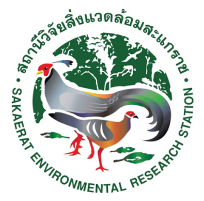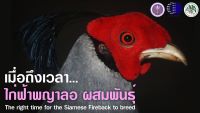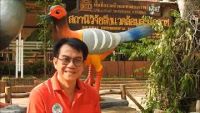Keywords :
Habitat Selection; Abundance Estimates; Siamese Fireback; Lophura diardi
บทคัดย่อ :
Siamese Fireback (Lopuhra diardi) is a distinctive and threatened galliform species restricted to lowland forest habitat. The aims of this study were to investigate the home range, habitat use, roosting behavior, roost-site selection, reproductive ecology and nest-site selection of lowland Siamese Fireback in Sakaerat Environmental Research Station, Nakhon Ratchsima, during 2010 - 2012. Eight female Siamese Firebacks from eight different groups were caught, fitted with radio-transmitters and followed for 2 - 27 months. The results showed that the average annual home range size was 31.4 (+-) 2.5 ha (n = 7). Non-breeding home range size was highest (26.3 (+-) 4.1 ha, n = 7), followed by breeding (21.7 (+-) 2.4 ha, n = 8) and chick rearing alone (9.7 (+-) 0.4 ha, n = 2) periods, respectively. From 480 habitat study plots (each a 10-m radius circular plot), females avoided loss of a brood by restricting their
movements to the smallest home ranges and selected areas with dense ground cover (<0.5 m height) and higher density of understory trees (>3 - 5 m in height). In addition, Siamese Firebacks selected areas on steeper slopes with less canopy cover for roosting (n = 52), presumably to facilitate escape-flushing when a predator attacked. During three breeding seasons, Siamese Fireback laid eggs from April to early August. From 18 nests monitored, the mean clutch size was 6.4 (+-) 0.3 eggs, ranging from four to eight eggs. The incubation period was 23 - 24 days and only 2 nests survived. Predation was the main cause of nest failure. Siamese Fireback appeared to prefer to nest in the buttresses of large trees, average diameter at breast high (DBH) of 185.4 (+-) 23.9 cm, (n = 15), ranging from 63.5 to 359.0 cm, and areas with dense vegetation coverage below 50 cm, on steeper slopes, near large basal areas of trees DBH >10 m and with low predation pressure (n = 21). Estimates of density based on camera trapping produced relatively precise density estimates in breeding season (5.6 birds km-2) with narrower confidence intervals than those of overestimates derived from distance sampling (40.3 birds km-2), and relatively accurate in comparison with radiotelemetry (16.7 birds km-2). This study has demonstrated the effectiveness of camera traps for estimating density of naturally unmarked Siamese Firebacks and encouraged the use of this technique to survey and monitor Southeast-Asian pheasants, including secretive terrestrial birds.
ไก่ฟ้าพญาลอ (Lophura diardi) เป็นไก่ฟ้าที่มีความสวยงามและเป็นชนิดพันธุ์ที่มี สถานภาพถูกคุกคาม การศึกษานี้มีวัตถุประสงค์เพื่อตรวจสอบขนาดถิ่นที่อยู่อาศัย การใช้พื้นที่อยู่ อาศัย พฤติกรรมการเกาะนอน การเลือกใช้พื้นที่เกาะนอน นิเวศวิทยาการสืบพันธุ์ และการเลือกใช้ พื้นที่ทำรังของไก่ฟ้าพญาลอที่อาศัยอยู่ในพื้นที่ป่าที่ราบต่ำในสถานีวิจัยสิ่งแวดล้อมสะแกราช จังหวัดนครราชสีมา ในปี พ.ศ. 2553-2555 ผลการศึกษาจากการใช้วิทยุติดตามตัว ไก่ฟ้าเพศเมีย จำนวน 8 ตัว จาก 8 กลุ่ม เป็นเวลา 2 ถึง 27 เดือน พบว่า ไก่ฟ้าพญาลอมีขนาดถิ่นที่อยู่อาศัยเฉลี่ยใน รอบปี 31.4 เฮกแตร์ โดยขนาดอาณาเขตในช่วงนอกฤดูผสมพันธุ์จะมีขนาดใหญ่ที่สุด (26.3 เฮก แตร์) รองลงมา คือ ช่วงฤดูผสมพันธุ์ (21.7 เฮกแตร์) และช่วงที่เลี้ยงลูกตามลำพัง (9.7 เฮกแตร์) ตามลำดับ จากการศึกษาสังคมพืช 480 แปลง (แปลงวงกลมรัศมี 10 เมตร) พบว่า ในช่วงที่เลี้ยงลูก ตัวเมียจะจำกัดการเคลื่อนไหวของตัวเองเพื่อหลีกเลี่ยงการสูญเสียลูก จึงส่งผลทำให้ถิ่นที่อยู่อาศัยมี ขนาดเล็กลง และเลือกเลี้ยงลูกในบริเวณที่มีการปกคลุมของพืชที่ระดับความสูง <0.5 เมตร และมี จำนวนต้นไม้ที่มีความสูง >3 - 5 เมตร ค่อนข้างหนาแน่น สำหรับการเลือกใช้พื้นที่เกาะนอน พซ้ำว่า ไก่ฟ้าพญาลอเลือกเกาะนอนบริเวณพื้นที่ที่มีความลาดชันสูง แต่มีการปกคลุมของเรือนยอดที่ระดับ ความสูง >5 เมตร ค่อนข้างต่ำ คาดว่าเพื่อให้สะดวกในการบินหนีเมื่อถูกผู้ล่าจู่โจม
ในช่วงฤดูผสมพันธุ์ ไก่ฟ้าพญาลอจะเริ่มวางไข่ตั้งแต่เดือนเมษายนถึงต้นเดือนสิงหาคม จากการติดตามเก็บข้อมูลรังจำนวน 18 รัง พบจำนวนไข่เฉลี่ย 6.4 (+-) 0.3 ฟองต่อครอก (4 - 8 ฟองต่อ ครอก) ระยะเวลากกไข่นาน 23 - 24 วัน ไข่จึงจะฟักเป็นตัว และพบว่ามีเพียง 2 รังเท่านั้นที่รอดพ้น จากการโดนล่า ทั้งนี้การล่าและทำลายรังจากสัตว์ผู้ล่าถือเป็นสาเหตุหลักที่ทำให้การทำรังล้มเหลว โดยส่วนใหญ่ไก่ฟ้าพญาล
เอกสารอ้างอิง :
Suwanrat, S. (2013). Habitat selection and abundance estimates of Siamese Fireback Lophura diardi at Sakaerat Environmental Research Station (Doctoral dissertation, School of Biology Institute of Science Suranaree University of Technology).



